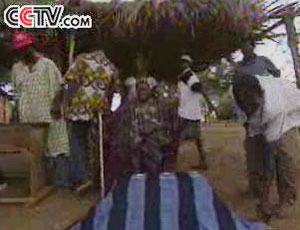Source: CCTV.com
10-25-2006 17:31
 |
The television crew of A Passage to Africa that is to follow the southern line of the African tour reaches Cape Town and the workers got ready for their job.
The crew drives along the southwest coast of the peninsula to the world-famous Cape of Good Hope.
A lot of people take Cape of Good Hope to be the southernmost tip of Africa but, in reality, this is not the case. The continent's southern point is Cape Agulhas, some 80 kilometers from Cape of Good Hope, which is actually Africa's southwestern point. The cape got its name from a historically significant navigation of 500 years ago.
 |
In the 15th century European princes had been eager in their search for a marine route to India, a legendary land of gold and riches.
In this pursuit of gold, in August 1487, Bartolomeu Dias's fleet rounded an uncharted cape in southern Africa, after having been tossed on the tough ocean for two weeks. The Portuguese navigator was so deeply impressed with the storms off the cape that he named it the Cape of Storms. At last they had reached the Indian Ocean. King John II of Portugal renamed the cape Cape of Good Hope to celebrate Dias's find and the sea route around the Cape of Good Hope went on to become the busiest line connecting the west with the east. The Europeans called it their lifeline on the ocean.
Waves crash on rocks and the water disperses into a semi-transparent mist for sunshine to create rainbows in the air, giving South Africa, a multi-racial country, the name 'land of rainbows'. People of different races now live peacefully on this land but centuries ago the land knew only turbulence and bloodshed.
The television crew leaves the Cape of Good Hope for Cape Town.
 |
South Africa has three capitals, with Pretoria being the administrative capital, Bloemfontein the judicial capital, and Cape Town the legislative capital. Cape Town is also the country's financial and industrial center. The city is beautiful and has a pleasant climate and Table Bay is big enough to allow 40 deep-sea tankers to moor. Behind the bay is Table Mountain which soars 1082 meters above sea level and which has a plateau that looks like a huge table. It is therefore called the dinner table of the gods.
The Portuguese who discovered the Cape of Good Hope didn't make their way deep into Africa from this point and other Europeans didn't get much of a foothold until the Dutch East Indian Company established the first settlement here, which was to become known as Cape Town. These European intruders brought slavery to the indigenous people, abducting the black people and forcing them to work their farms. This Dutch rule of Cape Town remained unchallenged for 140 years until the arrival of the greatest colonists of 19th century world, the British.
Editor:Wang Ping
